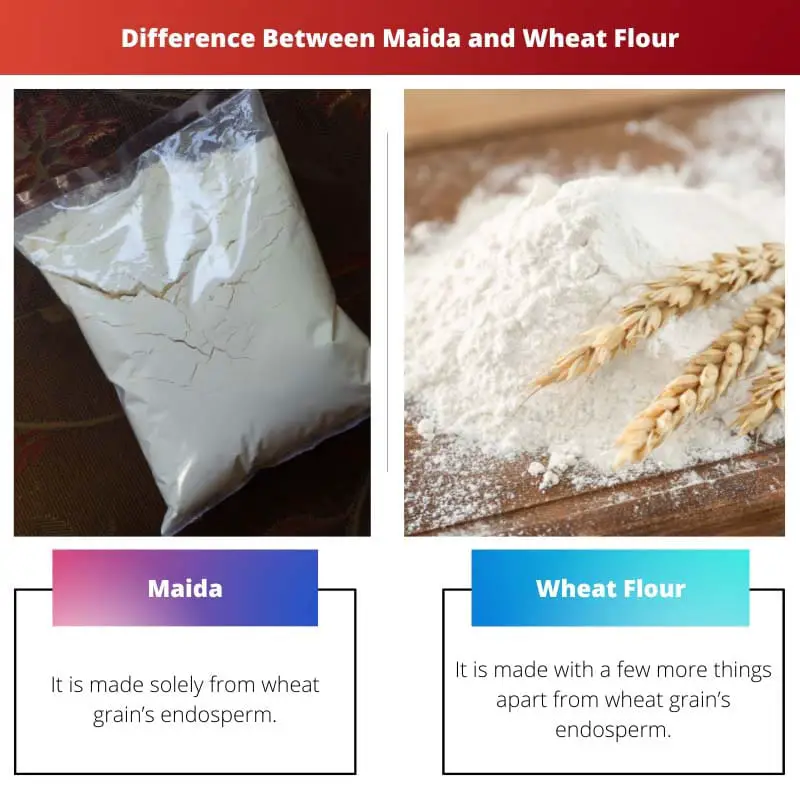There are over hundreds of varieties available all around the world when one searches for grains. Most of the grains are made into flour by grinding.
Both maida and wheat flour are made by grinding wheat but still, they are very different from each other and can be utilized by people differently.
Key Takeaways
- Maida, a refined wheat flour, contains fewer nutrients than whole wheat flour due to the removal of bran and germ during processing.
- Whole wheat flour, a healthier option, retains its fiber content and provides various health benefits like improved digestion and reduced risk of heart disease.
- Maida can rapidly increase blood sugar levels, making whole wheat flour a better option for people with diabetes or those watching their sugar intake.
Maida vs Wheat Flour
Maida is a refined wheat flour that is used in Indian cuisine. It is made from wheat that has been stripped of its bran and germ. Wheat flour is a whole grain flour that is common in many other parts of the world. It is made from the whole grain, including the bran and germ.

Maida is widely in use over the world and in a lot of cuisines. It is made up of wheat grain’s most important part, and that is the endosperm. It is scientifically proven to be containing a lot of calories and also is chemically bleached in order to give a pure white color.
Wheat flour is largely used in Indian as well as Mexican cuisine. Many people call it very similar to maida, but it is not.
Wheat flour also contains endosperm, but additionally, it has husk, germ, and bran also. Unlike Maida, it is not chemically bleached and retains the original color.
Comparison Table
| Parameters of Comparison | Maida | Wheat Flour |
|---|---|---|
| Made from | It is made solely from wheat grain’s endosperm. | It is made with a few more things apart from wheat grain’s endosperm. |
| Contains husk, bran, germ | No, it does not contain husk, bran, or germ. | Yes, it contains other things like bran, germ, and husk. |
| Bleached | It is bleached chemically in production factories. | It is not bleached chemically in production factories. |
| Nutrition | It has a lot of calories. | It has vitamins, minerals, and fibers. |
| Used for | It is used to make bread, cake, muffins, etc. | It is used to make tacos, chapati, puri, etc. |
What is Maida?
Maida is a very important part of the ingredients used in the kitchen. It is used to make a variety of dishes and food items, but still, many people are unaware of where maida comes from.
It is also commonly known as all-purpose flour.
To understand how maida is prepared, one can imagine refining wheat green to a great extent and making it very fine or powder-like.
This process takes place in factories where wheat grain is refined and also chemically bleached in order to make it more white in color.
Maida is used to making a variety of food items and specialty bakery items like muffins, noodles, cookies, pasta, cakes, bread, etc. However, this process degrades the nutritional value and quality of maida.
This is one of the reasons why maida lacks nutrition like minerals, fibers, or vitamins. On the other hand, it is very rich in calories and gives you an instant boost of energy on consumption.
It contains an endosperm of wheat grain but lacks husk, germ, and bran, which are present in wheat flour.
It is not regarded as a healthy option of food since it also has a high glycemic index which can contribute to raising blood sugar levels. It must be strictly avoided by diabetic patients.

What is Wheat Flour?
Wheat flour is a very commonly used and heard kitchen ingredient that is available all around the world and used extensively on a daily basis.
It is used to make a variety of dishes from starters to Evan desserts, and the best part about using wheat flour is that it is full of nutrition. It consists of the endosperm of wheat grain as well as bran and germ.
On the contrary to maida, wheat flour is rich in vitamins, fibers, and minerals, while it is also not very rich in calories.
Wheat flour is not refined or chemically bleached and so retains its natural color and texture while maintaining its positive contents.
Adding wheat flour to the diet is a very healthy option and is suggested by several nutritionists around the world.
Apart from this, wheat flour is also rich in antioxidants and amino acids which help the body to naturally treat issues like insomnia and anxiety, headache, and depression while it also helps in relaxing the body.
It is easier to digest as compared to mother and is used to prepare a lot of items like roti chapati taco and desserts, especially from the Indian and Mexican cuisines.

Main Differences Between Maida and Wheat Flour
- Both Maida and wheat flour are primarily made from wheat grain, but the latter contains some more things in addition to endosperm.
- Maida does not contain husk, bran, and germ, whereas wheat flour contains all these three things and endosperm.
- Maida is refined and bleached chemically in factories to give a pure white color and smooth texture. On the other hand, wheat flour is not chemically bleached.
- The nutritional value of maida and wheat flour is also different. While on the one hand, Maida contains a lot of calories. On the other hand, wheat flour contains a lot of vitamins, fibers, and minerals.
- Maida can be brought into use for making a lot of bakery products like cakes, bread, toast, etc., while wheat flour is used to make rotis, chapati, pancakes, etc.

- https://ifst.onlinelibrary.wiley.com/doi/abs/10.1046/j.1365-2621.2002.00553.x
- https://onlinelibrary.wiley.com/doi/abs/10.1111/j.1757-837X.2012.00164.x
